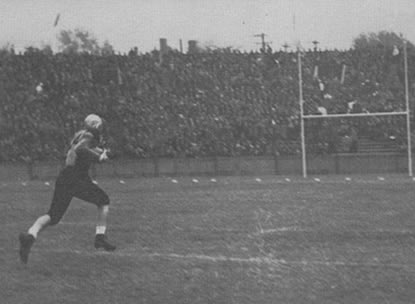Oct. 24, 2007
![]() CHC- Ricketson’s Historical Touchdown | CHC Archive
CHC- Ricketson’s Historical Touchdown | CHC Archive
 |
|
This week marked the 70th anniversary of Vanderbilt tackle Greer Ricketson’s historic touchdown run against LSU at Dudley Field. Earlier this year on July 31, Dr. Ricketson passed away at age 90. This interview and story with Ricketson and this writer is from 2004.
On October 23, 1937, the sixth-ranked LSU Tigers came into Dudley Field looking for a consecutive SEC championship. But, an historic play by coach Ray Morrison’s Commodores ruined those plans.
Both teams entered the game undefeated with LSU unscored on. Vanderbilt was 4-0 with wins over Kentucky, Chicago, Southwestern (Memphis) and SMU. Over 18,000 fans filled the stadium.
“This was a special game for the reason that they were highly ranked,” said Greer Ricketson “According to Morrison, LSU was going to be particularly tough because they hadn’t lost a game since the year before. We had not lost a game, but had not done as well as LSU. I think he realized that it was just straight football that we weren’t going to win.
“So he thought he had to dream up something. Some trick play that might affect the game. As it turned out, that’s the way it worked (the upcoming historic play). When we got ahead, our boys probably put out more effort and energy. And it swayed LSU a little. They were sort of dejected when that happened. So it worked the way the coach was hoping it would.”
The Tennessean reported on the pre-game festivals:
Ten minutes before the opening kickoff both teams having concluded their preliminary workouts, quit the field in favor of the band which played the national anthem while a crowd of more than 18,000 stood at attention.
It is winter weather and there is a brisk wind blowing across the field from the northwest. The temperature is 30 degrees and the skies are gray overhead, with no semblance of sunshine.
At 2:25 Vanderbilt came on the field with its starting lineup for a run down the terrain, Capt. Carl Hinkle of Vandy and James Warbrood of L.S.U. met for the toss-up. Hinkle won the toss and will defend the north goal. L.S.U., which was tardy coming of the field, will kick off.
Vanderbilt’s Jimmy Huggins took the kickoff, and raced to the Vandy 43-yard line for a return of 13 yards. Halfback Clarence Reinschmidt was stopped after a yard gain on first down. He was stopped two more times, failing to gain a first down. Huggins punted the ball 61 yards to the LSU 12-yard line without a return.
LSU was forced to punt with outstanding defensive plays by Vanderbilt’s defensive tackle Buford “Baby” Ray. Huggins handled the punt at the Commodore 30, and was downed at the Vandy 43-yard.
On first down, quarterback Huggins, ran off the left guard for a six-yard gain. Now The Tennessean describes “The Play:”
Ninety-nine percent of the spectators and 100 per cent of the Louisiana team thought Dutch Reinschmidt, who had been almost under center at the snap had the ball as he raced to the South side of the field. He gradually faded back with three men in front of him for interference.
Greer Ricketson, playing left tackle, had pulled out as if to go around and block for Huggins. He took the ball from where Reinschmidt had intentionally fumbled or placed it on the ground, stopped momentarily while the Tigers stormed to the left. Then he came up from his crouch and started down the West sidelines with Preacher Franklin leading interference.
Ricketson streaked 51 yards for a Vanderbilt touchdown. Joe Agee kicked the conversion and the enchanted, but bewildered fans stayed on their feet for several minutes. Vanderbilt led early in the first quarter 7-0, and even the sportswriters were confused as to what happened on that play.
“We ran the play just as exactly as he (Morrison) told us the way to do it,” said Ricketson. “The week before the game, he kept 11 of us out on the practice field while the rest of the team had gone in. He tried to keep it that secret while we practiced it on the field. It didn’t wind up quite that secret. Some of the other boys found out about it. I had one friend who said he was in the stands and somebody had told him, but I don’t think he knew the details.
“Before the game the coaches explained to the referee what the play was going to be and how it was going to be run. The coaches were afraid that the referees might blow the whistle and thought something was so unusual to stop the play. When we called the play, the quarterback turned around to the referee and said, `This is it.’ So he did and it worked just right.”
Ricketson said that the Vanderbilt line coach (Henry Frnka) didn’t want to run the play. The coach thought it was too dangerous and might backfire. In order to win the line coach over Morrison named the play after the line coach. The players had a private nickname for Frnka that was “Pig Eye.”
Of course, they never called the line coach that in front of him. When it was time to run the play, the quarterback just said in the huddle, “Pig Eye.” The players knew it was time to run that special trick play.
In the book by Fred Russell and Maxwell Benson, Fifty Years of Vanderbilt Football published in 1938, the play was explained:
Reinschmidt, getting the ball from center, spun, concealed the football on the ground behind a Vanderbilt lineman, then faked cleverly around his left end. The entire LSU team and even the officials went after him. Suddenly, Tackle Greer Ricketson, who had started out to follow the play, then fallen purposely over the ball, arose, picked up the leather and raced 50 yards for the touchdown as the mystified thousands asked each other what happened.
Movies of the play were run and rerun, but a question then surfaced; did Ricketson’s knee touch the ground? That question will remain unanswered without any certainly.
Ricketson said he was chosen to run with the ball since he was the fastest lineman. Also the year before, Ricketson played end and was familiar with running with the football. Ricketson was asked to give his insight of the famous play.
“We were close to the right sideline in about middle field,” said Ricketson. “I think we were on about the 50-yard line or something like that. The reason we were over there, the play was designed for the running backs to make a wide end sweep to the left side. They were to try and pull the LSU players over that way to leave the right side of the field open.
“I switched form tackle position to guard and pulled out like a running guard back in the backfield. Then I did a fake stumble and fall. The guard and the tackle on the left side assignment were to block still and not let anybody break through. They didn’t charge into the defense, they tried to make a wall. My assignment was to stay on the ground to the count of three. The ball had been put on the ground by one of the halfbacks. He got under center like a T-formation, which we didn’t play back in those days.
“He took the ball from the center and turned to his left, laid it on the ground behind the guard and tackle. He came up as if he had the ball and ran a wide end sweep. All the rest of the backfield was blocking for him. I picked up the ball and ran straight down the field, which was wide open.”
The game remained 7-0, until the close of the fourth quarter. With only two minutes remaining in the game, LSU had the ball on the Vandy 37-yard line with a first down. Two plays later, a pass interference call on the Commodore defense placed the ball at the 18-yard line.
Jabbo Stell then caught a pass in front of the goal line, and carried it in for the LSU touchdown. The score was now 7-6, with LSU’s conversion attempt forthcoming.
On the extra-point attempt, the center’s snap went past the kicker and holder then bounced to the 20-yard line. Vanderbilt’s Ray and Ed Merlin jumped on the ball securing a Vanderbilt one-point lead.
LSU kicked the ball to Vanderbilt where they ran out the clock. The fans stormed the field and carried the players to their clubhouse after the 7-6 win.
The South was stunned at the news of the LSU loss in Nashville and that an LSU 14-game conference win streak was broken. Vanderbilt gained 238 total yards against the Tigers’ 90 yards. LSU only managed nine first downs compared to the Commodores 16.
In the latter weeks Vanderbilt lost to Georgia Tech, beat Sewanee, Tennessee and concluded the season with a loss to Alabama. It wasn’t known at the time, but if Vanderbilt (8-1) had beaten the Tide, they would have gone to the Rose Bowl. The undefeated Crimson Tide were invited to Pasadena.
Ricketson was asked that after 67 years do people still ask him about that play?
“I will be at a place and somebody will ask, `You carried the ball didn’t you in the Vanderbilt/LSU game?’ said Ricketson. “It has just hung on all these years. I’ve sort of kidded in a nasty sort of way. When I get to know some of the coaches over there at Vanderbilt, I tell them I wish that they would do something good so they’d quit talking about that LSU/Vanderbilt hidden ball play.”
If you have comments or suggestions you can contact Bill Traughber via e-mail WLTraughber@aol.com.



